Analyzing Social Science Data Using Quantitative Research Methods
VerifiedAdded on 2023/06/13
|6
|1518
|351
Homework Assignment
AI Summary
This assignment delves into quantitative research methods within the social sciences, covering four levels of measurement: nominal, ordinal, interval, and ratio. It explains measures of central tendency (mean, mode, median) and dispersion (range, interquartile range, standard deviation), highlighting their use in descriptive statistics. The document differentiates between descriptive and inferential statistics, outlining their respective roles in data analysis. Key statistical terms such as hypothesis, null hypothesis, independent and dependent variables, and extraneous variables are defined. The assignment concludes with an interpretation of a frequency table, cross-tabulation, chi-square result, and Phi/Cramer’s V, demonstrating the practical application of these methods. Desklib provides access to similar assignments and study resources for students.
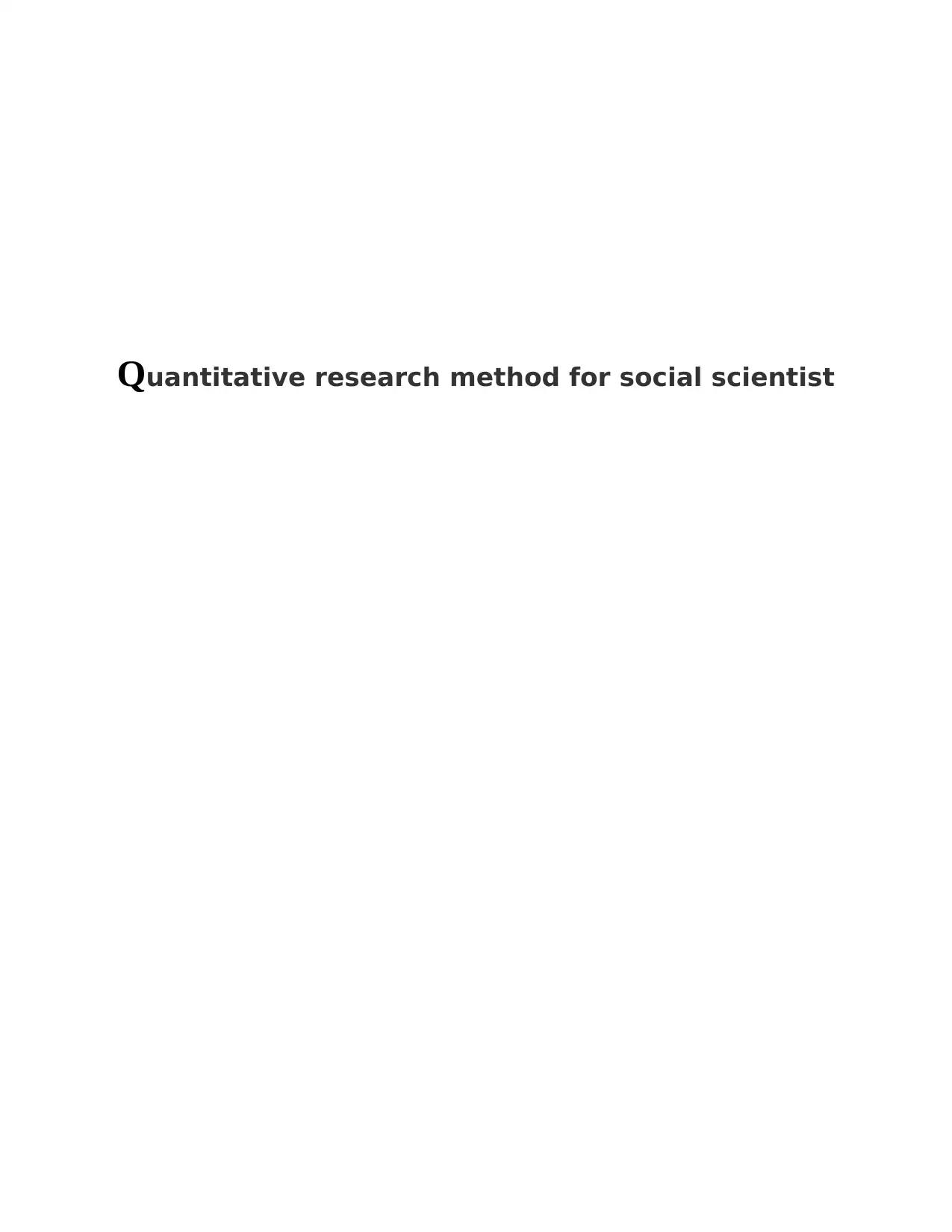
Quantitative research method for social scientist
Paraphrase This Document
Need a fresh take? Get an instant paraphrase of this document with our AI Paraphraser
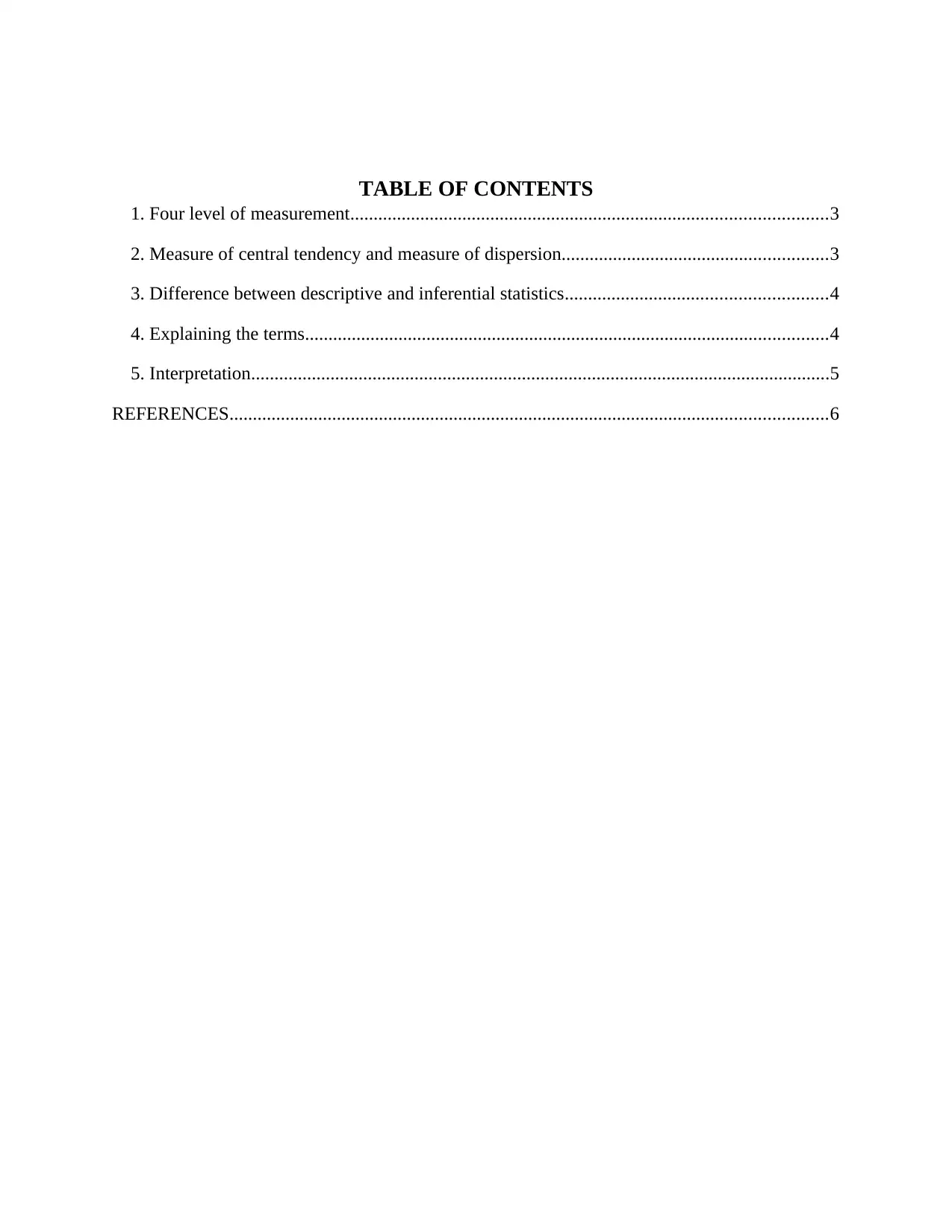
TABLE OF CONTENTS
1. Four level of measurement......................................................................................................3
2. Measure of central tendency and measure of dispersion.........................................................3
3. Difference between descriptive and inferential statistics........................................................4
4. Explaining the terms................................................................................................................4
5. Interpretation............................................................................................................................5
REFERENCES................................................................................................................................6
1. Four level of measurement......................................................................................................3
2. Measure of central tendency and measure of dispersion.........................................................3
3. Difference between descriptive and inferential statistics........................................................4
4. Explaining the terms................................................................................................................4
5. Interpretation............................................................................................................................5
REFERENCES................................................................................................................................6
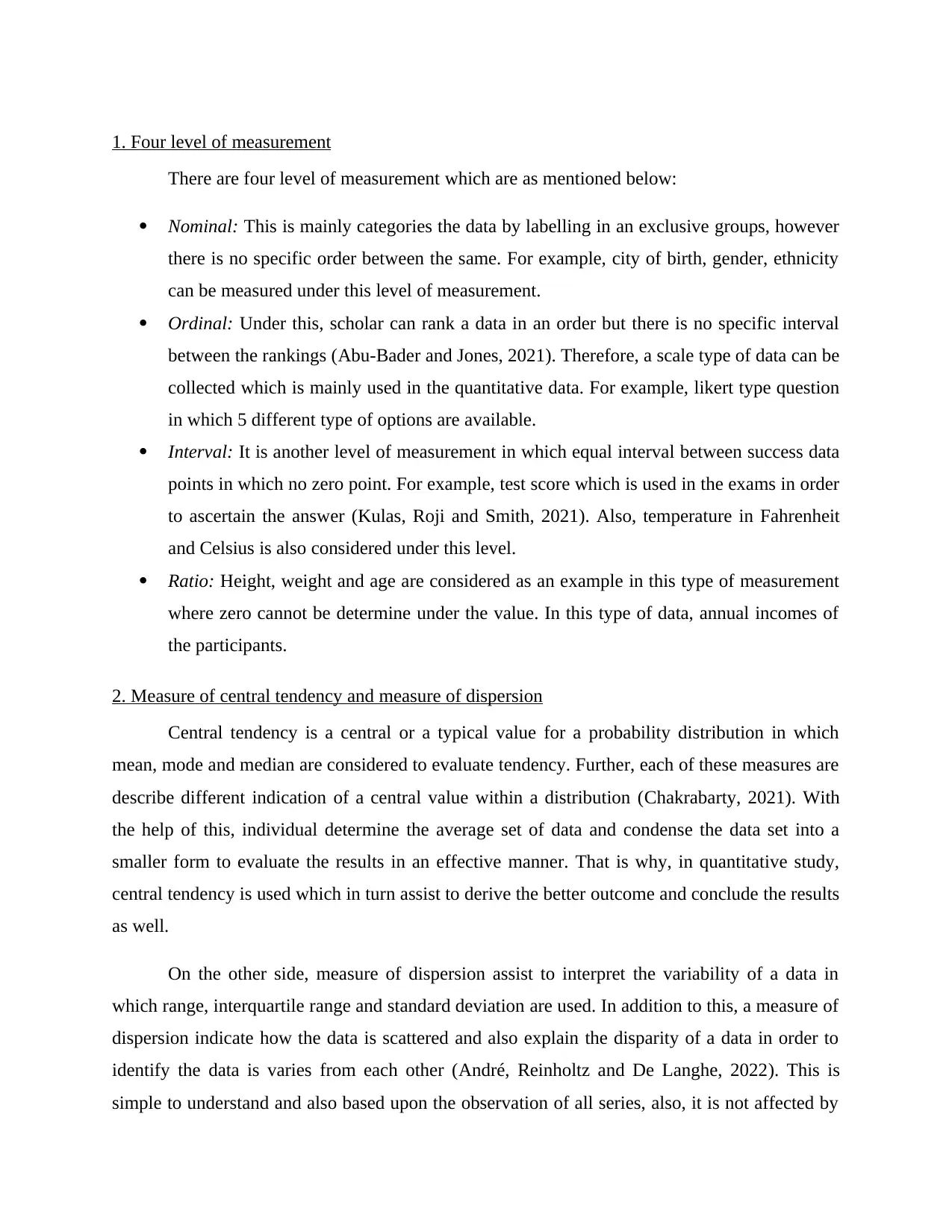
1. Four level of measurement
There are four level of measurement which are as mentioned below:
Nominal: This is mainly categories the data by labelling in an exclusive groups, however
there is no specific order between the same. For example, city of birth, gender, ethnicity
can be measured under this level of measurement.
Ordinal: Under this, scholar can rank a data in an order but there is no specific interval
between the rankings (Abu-Bader and Jones, 2021). Therefore, a scale type of data can be
collected which is mainly used in the quantitative data. For example, likert type question
in which 5 different type of options are available.
Interval: It is another level of measurement in which equal interval between success data
points in which no zero point. For example, test score which is used in the exams in order
to ascertain the answer (Kulas, Roji and Smith, 2021). Also, temperature in Fahrenheit
and Celsius is also considered under this level.
Ratio: Height, weight and age are considered as an example in this type of measurement
where zero cannot be determine under the value. In this type of data, annual incomes of
the participants.
2. Measure of central tendency and measure of dispersion
Central tendency is a central or a typical value for a probability distribution in which
mean, mode and median are considered to evaluate tendency. Further, each of these measures are
describe different indication of a central value within a distribution (Chakrabarty, 2021). With
the help of this, individual determine the average set of data and condense the data set into a
smaller form to evaluate the results in an effective manner. That is why, in quantitative study,
central tendency is used which in turn assist to derive the better outcome and conclude the results
as well.
On the other side, measure of dispersion assist to interpret the variability of a data in
which range, interquartile range and standard deviation are used. In addition to this, a measure of
dispersion indicate how the data is scattered and also explain the disparity of a data in order to
identify the data is varies from each other (André, Reinholtz and De Langhe, 2022). This is
simple to understand and also based upon the observation of all series, also, it is not affected by
There are four level of measurement which are as mentioned below:
Nominal: This is mainly categories the data by labelling in an exclusive groups, however
there is no specific order between the same. For example, city of birth, gender, ethnicity
can be measured under this level of measurement.
Ordinal: Under this, scholar can rank a data in an order but there is no specific interval
between the rankings (Abu-Bader and Jones, 2021). Therefore, a scale type of data can be
collected which is mainly used in the quantitative data. For example, likert type question
in which 5 different type of options are available.
Interval: It is another level of measurement in which equal interval between success data
points in which no zero point. For example, test score which is used in the exams in order
to ascertain the answer (Kulas, Roji and Smith, 2021). Also, temperature in Fahrenheit
and Celsius is also considered under this level.
Ratio: Height, weight and age are considered as an example in this type of measurement
where zero cannot be determine under the value. In this type of data, annual incomes of
the participants.
2. Measure of central tendency and measure of dispersion
Central tendency is a central or a typical value for a probability distribution in which
mean, mode and median are considered to evaluate tendency. Further, each of these measures are
describe different indication of a central value within a distribution (Chakrabarty, 2021). With
the help of this, individual determine the average set of data and condense the data set into a
smaller form to evaluate the results in an effective manner. That is why, in quantitative study,
central tendency is used which in turn assist to derive the better outcome and conclude the results
as well.
On the other side, measure of dispersion assist to interpret the variability of a data in
which range, interquartile range and standard deviation are used. In addition to this, a measure of
dispersion indicate how the data is scattered and also explain the disparity of a data in order to
identify the data is varies from each other (André, Reinholtz and De Langhe, 2022). This is
simple to understand and also based upon the observation of all series, also, it is not affected by
⊘ This is a preview!⊘
Do you want full access?
Subscribe today to unlock all pages.

Trusted by 1+ million students worldwide
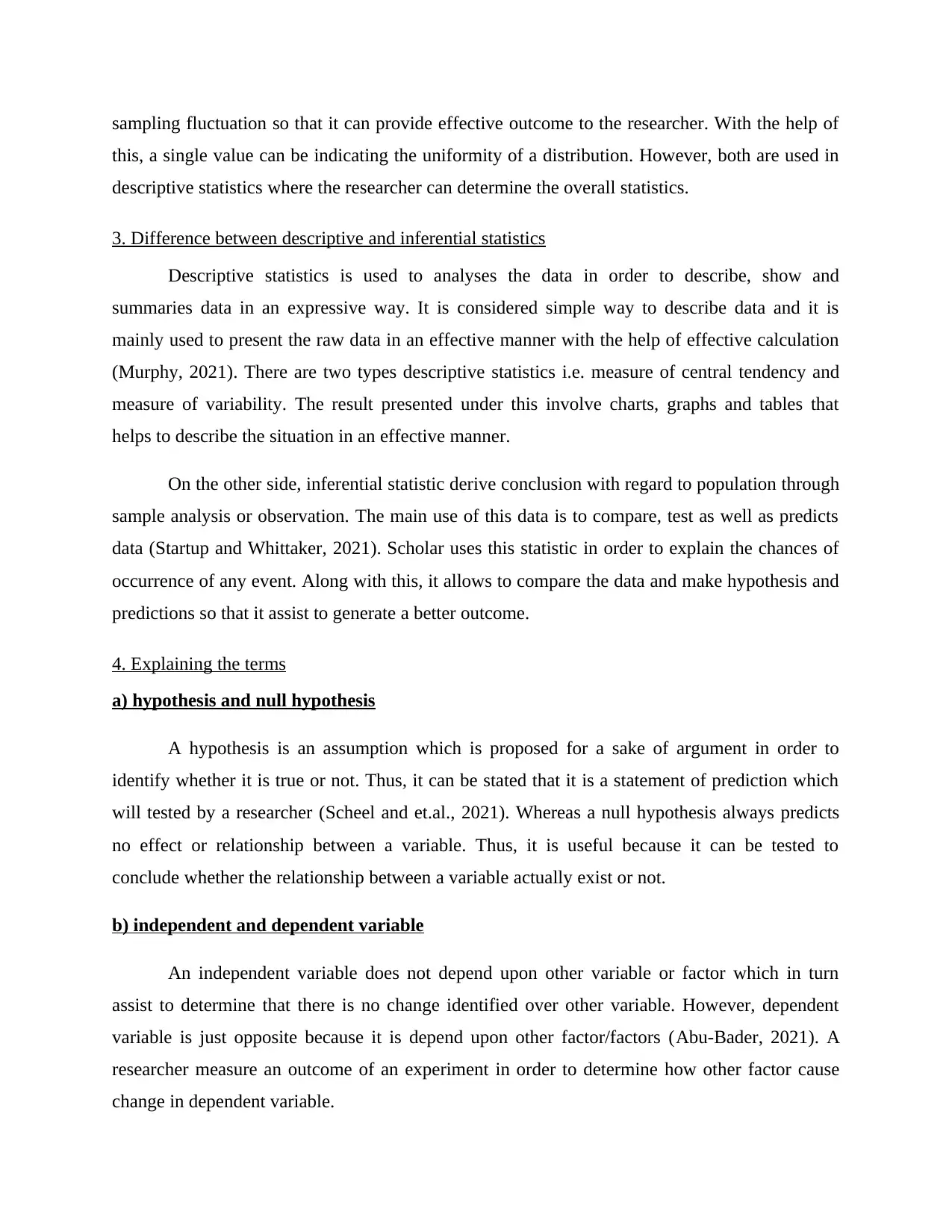
sampling fluctuation so that it can provide effective outcome to the researcher. With the help of
this, a single value can be indicating the uniformity of a distribution. However, both are used in
descriptive statistics where the researcher can determine the overall statistics.
3. Difference between descriptive and inferential statistics
Descriptive statistics is used to analyses the data in order to describe, show and
summaries data in an expressive way. It is considered simple way to describe data and it is
mainly used to present the raw data in an effective manner with the help of effective calculation
(Murphy, 2021). There are two types descriptive statistics i.e. measure of central tendency and
measure of variability. The result presented under this involve charts, graphs and tables that
helps to describe the situation in an effective manner.
On the other side, inferential statistic derive conclusion with regard to population through
sample analysis or observation. The main use of this data is to compare, test as well as predicts
data (Startup and Whittaker, 2021). Scholar uses this statistic in order to explain the chances of
occurrence of any event. Along with this, it allows to compare the data and make hypothesis and
predictions so that it assist to generate a better outcome.
4. Explaining the terms
a) hypothesis and null hypothesis
A hypothesis is an assumption which is proposed for a sake of argument in order to
identify whether it is true or not. Thus, it can be stated that it is a statement of prediction which
will tested by a researcher (Scheel and et.al., 2021). Whereas a null hypothesis always predicts
no effect or relationship between a variable. Thus, it is useful because it can be tested to
conclude whether the relationship between a variable actually exist or not.
b) independent and dependent variable
An independent variable does not depend upon other variable or factor which in turn
assist to determine that there is no change identified over other variable. However, dependent
variable is just opposite because it is depend upon other factor/factors (Abu-Bader, 2021). A
researcher measure an outcome of an experiment in order to determine how other factor cause
change in dependent variable.
this, a single value can be indicating the uniformity of a distribution. However, both are used in
descriptive statistics where the researcher can determine the overall statistics.
3. Difference between descriptive and inferential statistics
Descriptive statistics is used to analyses the data in order to describe, show and
summaries data in an expressive way. It is considered simple way to describe data and it is
mainly used to present the raw data in an effective manner with the help of effective calculation
(Murphy, 2021). There are two types descriptive statistics i.e. measure of central tendency and
measure of variability. The result presented under this involve charts, graphs and tables that
helps to describe the situation in an effective manner.
On the other side, inferential statistic derive conclusion with regard to population through
sample analysis or observation. The main use of this data is to compare, test as well as predicts
data (Startup and Whittaker, 2021). Scholar uses this statistic in order to explain the chances of
occurrence of any event. Along with this, it allows to compare the data and make hypothesis and
predictions so that it assist to generate a better outcome.
4. Explaining the terms
a) hypothesis and null hypothesis
A hypothesis is an assumption which is proposed for a sake of argument in order to
identify whether it is true or not. Thus, it can be stated that it is a statement of prediction which
will tested by a researcher (Scheel and et.al., 2021). Whereas a null hypothesis always predicts
no effect or relationship between a variable. Thus, it is useful because it can be tested to
conclude whether the relationship between a variable actually exist or not.
b) independent and dependent variable
An independent variable does not depend upon other variable or factor which in turn
assist to determine that there is no change identified over other variable. However, dependent
variable is just opposite because it is depend upon other factor/factors (Abu-Bader, 2021). A
researcher measure an outcome of an experiment in order to determine how other factor cause
change in dependent variable.
Paraphrase This Document
Need a fresh take? Get an instant paraphrase of this document with our AI Paraphraser
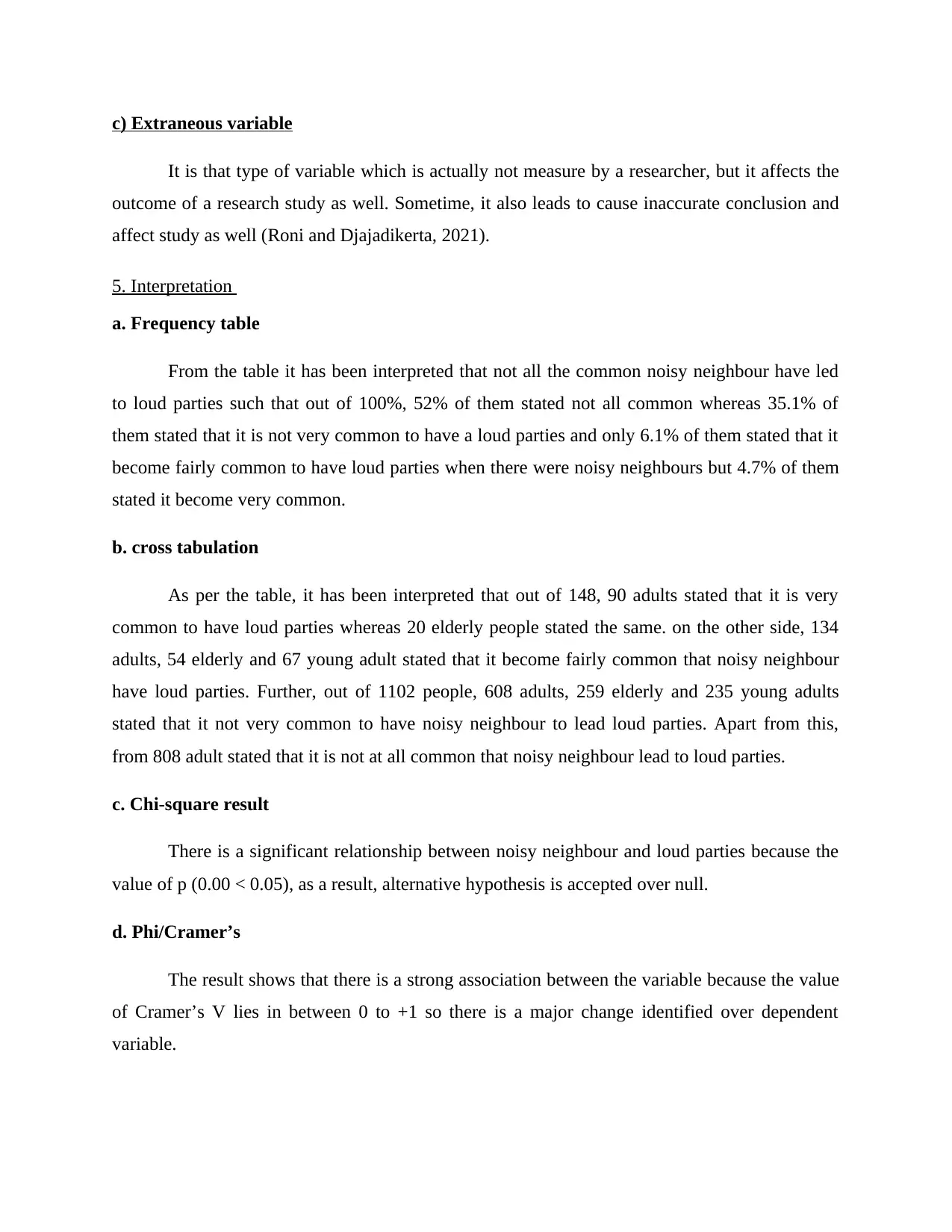
c) Extraneous variable
It is that type of variable which is actually not measure by a researcher, but it affects the
outcome of a research study as well. Sometime, it also leads to cause inaccurate conclusion and
affect study as well (Roni and Djajadikerta, 2021).
5. Interpretation
a. Frequency table
From the table it has been interpreted that not all the common noisy neighbour have led
to loud parties such that out of 100%, 52% of them stated not all common whereas 35.1% of
them stated that it is not very common to have a loud parties and only 6.1% of them stated that it
become fairly common to have loud parties when there were noisy neighbours but 4.7% of them
stated it become very common.
b. cross tabulation
As per the table, it has been interpreted that out of 148, 90 adults stated that it is very
common to have loud parties whereas 20 elderly people stated the same. on the other side, 134
adults, 54 elderly and 67 young adult stated that it become fairly common that noisy neighbour
have loud parties. Further, out of 1102 people, 608 adults, 259 elderly and 235 young adults
stated that it not very common to have noisy neighbour to lead loud parties. Apart from this,
from 808 adult stated that it is not at all common that noisy neighbour lead to loud parties.
c. Chi-square result
There is a significant relationship between noisy neighbour and loud parties because the
value of p (0.00 < 0.05), as a result, alternative hypothesis is accepted over null.
d. Phi/Cramer’s
The result shows that there is a strong association between the variable because the value
of Cramer’s V lies in between 0 to +1 so there is a major change identified over dependent
variable.
It is that type of variable which is actually not measure by a researcher, but it affects the
outcome of a research study as well. Sometime, it also leads to cause inaccurate conclusion and
affect study as well (Roni and Djajadikerta, 2021).
5. Interpretation
a. Frequency table
From the table it has been interpreted that not all the common noisy neighbour have led
to loud parties such that out of 100%, 52% of them stated not all common whereas 35.1% of
them stated that it is not very common to have a loud parties and only 6.1% of them stated that it
become fairly common to have loud parties when there were noisy neighbours but 4.7% of them
stated it become very common.
b. cross tabulation
As per the table, it has been interpreted that out of 148, 90 adults stated that it is very
common to have loud parties whereas 20 elderly people stated the same. on the other side, 134
adults, 54 elderly and 67 young adult stated that it become fairly common that noisy neighbour
have loud parties. Further, out of 1102 people, 608 adults, 259 elderly and 235 young adults
stated that it not very common to have noisy neighbour to lead loud parties. Apart from this,
from 808 adult stated that it is not at all common that noisy neighbour lead to loud parties.
c. Chi-square result
There is a significant relationship between noisy neighbour and loud parties because the
value of p (0.00 < 0.05), as a result, alternative hypothesis is accepted over null.
d. Phi/Cramer’s
The result shows that there is a strong association between the variable because the value
of Cramer’s V lies in between 0 to +1 so there is a major change identified over dependent
variable.
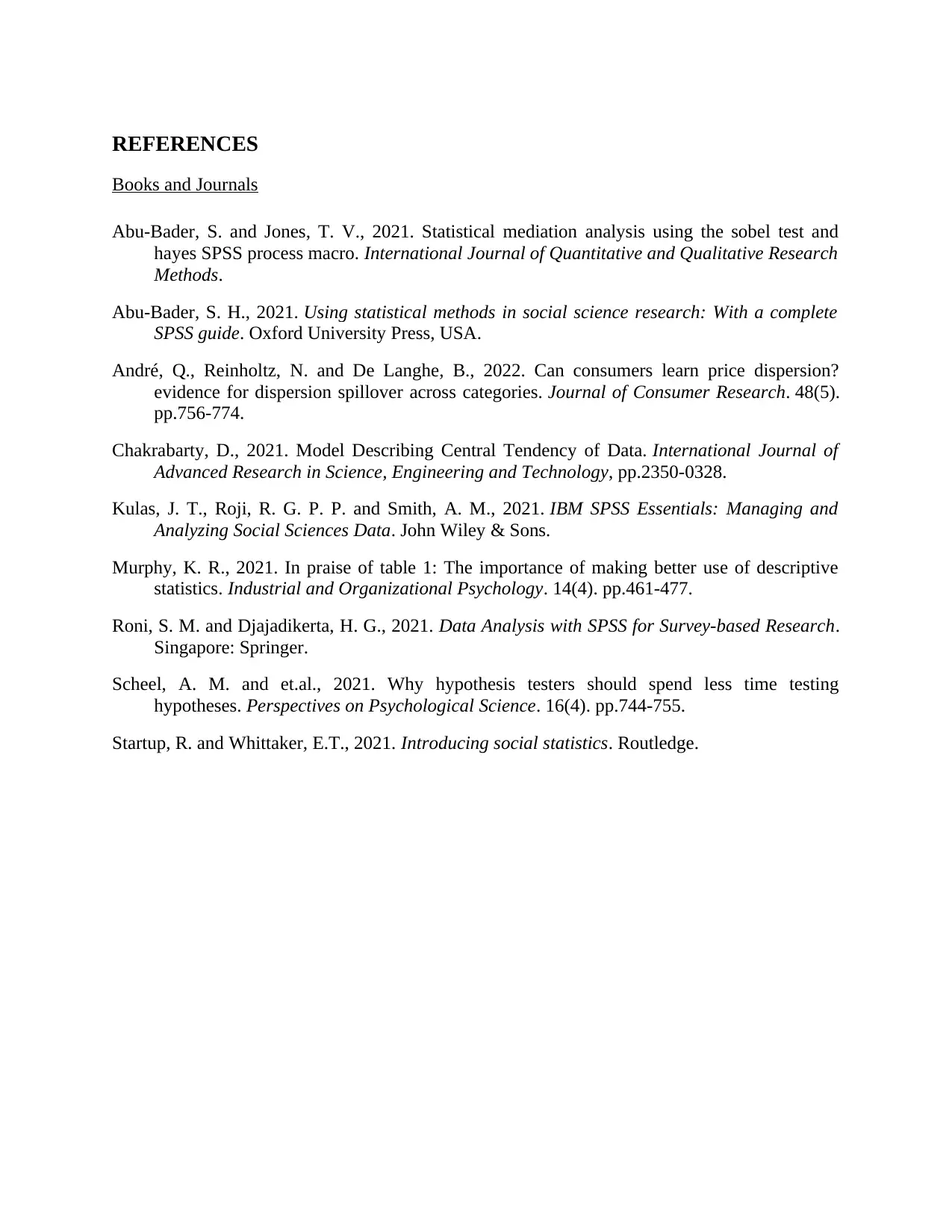
REFERENCES
Books and Journals
Abu-Bader, S. and Jones, T. V., 2021. Statistical mediation analysis using the sobel test and
hayes SPSS process macro. International Journal of Quantitative and Qualitative Research
Methods.
Abu-Bader, S. H., 2021. Using statistical methods in social science research: With a complete
SPSS guide. Oxford University Press, USA.
André, Q., Reinholtz, N. and De Langhe, B., 2022. Can consumers learn price dispersion?
evidence for dispersion spillover across categories. Journal of Consumer Research. 48(5).
pp.756-774.
Chakrabarty, D., 2021. Model Describing Central Tendency of Data. International Journal of
Advanced Research in Science, Engineering and Technology, pp.2350-0328.
Kulas, J. T., Roji, R. G. P. P. and Smith, A. M., 2021. IBM SPSS Essentials: Managing and
Analyzing Social Sciences Data. John Wiley & Sons.
Murphy, K. R., 2021. In praise of table 1: The importance of making better use of descriptive
statistics. Industrial and Organizational Psychology. 14(4). pp.461-477.
Roni, S. M. and Djajadikerta, H. G., 2021. Data Analysis with SPSS for Survey-based Research.
Singapore: Springer.
Scheel, A. M. and et.al., 2021. Why hypothesis testers should spend less time testing
hypotheses. Perspectives on Psychological Science. 16(4). pp.744-755.
Startup, R. and Whittaker, E.T., 2021. Introducing social statistics. Routledge.
Books and Journals
Abu-Bader, S. and Jones, T. V., 2021. Statistical mediation analysis using the sobel test and
hayes SPSS process macro. International Journal of Quantitative and Qualitative Research
Methods.
Abu-Bader, S. H., 2021. Using statistical methods in social science research: With a complete
SPSS guide. Oxford University Press, USA.
André, Q., Reinholtz, N. and De Langhe, B., 2022. Can consumers learn price dispersion?
evidence for dispersion spillover across categories. Journal of Consumer Research. 48(5).
pp.756-774.
Chakrabarty, D., 2021. Model Describing Central Tendency of Data. International Journal of
Advanced Research in Science, Engineering and Technology, pp.2350-0328.
Kulas, J. T., Roji, R. G. P. P. and Smith, A. M., 2021. IBM SPSS Essentials: Managing and
Analyzing Social Sciences Data. John Wiley & Sons.
Murphy, K. R., 2021. In praise of table 1: The importance of making better use of descriptive
statistics. Industrial and Organizational Psychology. 14(4). pp.461-477.
Roni, S. M. and Djajadikerta, H. G., 2021. Data Analysis with SPSS for Survey-based Research.
Singapore: Springer.
Scheel, A. M. and et.al., 2021. Why hypothesis testers should spend less time testing
hypotheses. Perspectives on Psychological Science. 16(4). pp.744-755.
Startup, R. and Whittaker, E.T., 2021. Introducing social statistics. Routledge.
⊘ This is a preview!⊘
Do you want full access?
Subscribe today to unlock all pages.

Trusted by 1+ million students worldwide
1 out of 6
Related Documents
Your All-in-One AI-Powered Toolkit for Academic Success.
+13062052269
info@desklib.com
Available 24*7 on WhatsApp / Email
![[object Object]](/_next/static/media/star-bottom.7253800d.svg)
Unlock your academic potential
Copyright © 2020–2025 A2Z Services. All Rights Reserved. Developed and managed by ZUCOL.


